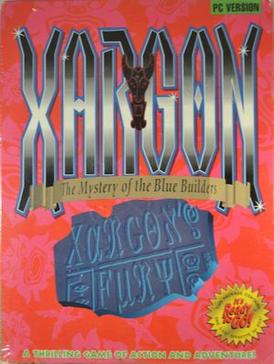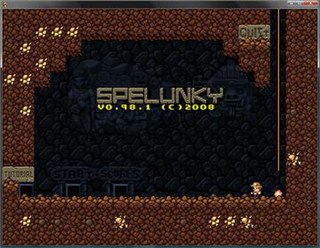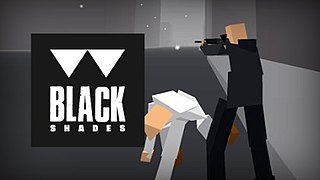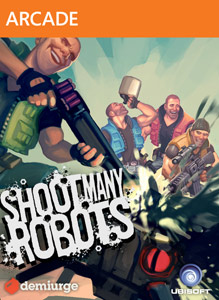
Rise of the Triad: Dark War is a first-person shooter video game, developed and published by Apogee Software in 1995. The player can choose to play as one of five different characters, each bearing unique attributes such as speed and endurance. The game's story follows these five characters who have been sent to investigate a deadly cult, and soon become aware of a deadly plot to destroy a nearby city. A remake was designed by Interceptor Entertainment and released by Apogee Games in 2013. The shareware version of the game is titled Rise of the Triad: The HUNT Begins.

Liero is a video game for MS-DOS, first released by Finnish programmer Joosa Riekkinen in 1998. The game has been described as a real-time version of Worms. Liero is Finnish for 'earthworm' and is pronounced. Inspired itself by the earlier game MoleZ, Liero provided inspiration for the later games Soldat and Noita.

Wolfenstein: Enemy Territory is a free and open-source multiplayer first-person shooter video game within the Wolfenstein series. It was originally planned to be released as a commercial expansion pack to Return to Castle Wolfenstein and later as a standalone game. However, due to problems with the single-player aspect, the multiplayer portion was released on 29 May 2003 as a freeware standalone game. In January 2004, the source code for the game logic was released to the benefit of its modding community.

Tempest is a 1981 arcade video game by Atari, Inc., designed and programmed by Dave Theurer. It takes place on a three-dimensional surface divided into lanes, sometimes as a closed tube, and viewed from one end. The player controls a claw-shaped "blaster" that sits on the edge of the surface, snapping from segment to segment as a rotary knob is turned, and can fire blaster shots to destroy enemies and obstacles by pressing a button.

Tyrian is a vertically scrolling shooter developed by Eclipse Software for MS-DOS and published in 1995 by Epic MegaGames. Tyrian was programmed by Jason Emery, illustrated by Daniel Cook, and its music composed by Alexander Brandon and Andras Molnar. The game was re-released as freeware in 2004. A free and open-source port of the game started in April 2007.

Warning Forever is a freeware fixed shooter for Microsoft Windows written by Japanese developer Hikoza T Ohkubo and released under the name of his software house, Hikware.

Dink Smallwood is an action role-playing video game developed by Robinson Technologies at the time consisting of Seth Robinson, Justin Martin, and Greg Smith. It was first released in 1998 before being released as freeware on October 17, 1999. Mitch Brink composed several of the game's music tracks while others are MIDI forms of classical music such as Debussy's "Reverie". The game has a small but constant fan following that continues to develop add-ons for the game more than two decades after its release. The game is also notable for its humorous dialogue and surrealistic themes in various scenes between the gameplay.

Raptor: Call of the Shadows is a vertically scrolling shooter developed by Cygnus Studios and published by Apogee Software. Its working title was "Mercenary 2029". It was released on April 1, 1994 for MS-DOS compatible systems. The first episode of the game, "Bravo Sector", was distributed as shareware, while the other two episodes were sold commercially.

Xargon: The Mystery of the Blue Builders is a video game trilogy produced by Epic MegaGames for DOS. The game is a side-scrolling platform game. The main character, Malvineous Havershim, must journey through strange landscapes as he seeks to destroy the evil Xargon.

Enemy Territory: Quake Wars is a first-person shooter video game developed by Splash Damage and published by Activision for Microsoft Windows, Linux, Mac OS X, PlayStation 3 and Xbox 360. The game was first released in the PAL region on September 28, 2007, and later in North America on October 2. It is a spinoff of the Quake series and the successor to 2003's Wolfenstein: Enemy Territory.

Xenon 2: Megablast is a 1989 shoot 'em up video game developed by The Bitmap Brothers and published by Image Works for the Amiga and Atari ST. It was later converted to the Master System, PC-98, X68000, Mega Drive, Commodore CDTV, Game Boy, Acorn Archimedes and Atari Jaguar platforms. The game is a sequel to Xenon and takes place a millennium after the previous title. The goal of the game is to destroy a series of bombs planted throughout history by the Xenites, the vengeful antagonists of the first game.

ABA Games is a Japanese video game developer, composed solely of game designer Kenta Cho. ABA Games' works, available as open source, are predominantly shoot 'em up games often inspired by classic games in the genre. Its games feature stylised retro graphics, innovative gameplay features and modes and feature random rather than scripted events. These creations have been acclaimed as some of the best independent games available, though some commentators, including Cho himself, feel they are too simple for commercial release.

Every Extend is series of puzzle shoot 'em up video games primarily developed by Q Entertainment. The series began with a 2004 freeware game of the same name for Windows, which was a personal project by Kanta Matsuhisa under the "Omega" pseudonym. Q Entertainment discovered the game online and approached Matshisa to develop a remix version. The remix version was developed for the PlayStation Portable and was released in 2006, titled Every Extend Extra. In 2007, Q Entertainment developed and released a sequel on the Xbox 360 titled Every Extend Extra Extreme.

Z is a 1996 real-time strategy computer game by The Bitmap Brothers. It is about two armies of robots battling to conquer different planets.

Savage: The Battle for Newerth is a 2003 video game combining aspects of the real-time strategy and first-person shooter genres, developed by S2 Games. It takes place in a science fantasy distant future when mankind has rebuilt society after the apocalypse, but is threatened by intelligent beasts led by a sorceress.

Kiloblaster is a fixed shooter video game trilogy written by Allen Pilgrim and published by Epic MegaGames in 1992 for IBM PC compatibles. Based on Namco's Galaxian from 1979, there are a few differences such as allowing greater player movement, much faster enemy movement, power-ups, enemies that take more than one hit, and allies to assist in battle.

Spelunky is a 2008 source-available 2D platform game created by independent developer Derek Yu and released as freeware for Microsoft Windows. It was remade for the Xbox 360 in 2012, with ports of the new version following for various platforms, including back to Microsoft Windows. The player controls a spelunker who explores a series of caves while collecting treasure, saving damsels, fighting enemies, and dodging traps. The caves are procedurally generated, making each run-through of the game unique.

Black Shades is a free and open-source video game developed by Wolfire Games. Originally released for Mac OS 9 it was ported to other platforms due to the source code availability. The player controls a psychic bodyguard who is tasked with protecting a VIP from a horde of zombies, snipers and other assorted would-be assassins.

Shoot Many Robots is a video game developed by Demiurge Studios and published by Ubisoft for Xbox Live Arcade, PlayStation Network, and Microsoft Windows via Steam. Shoot Many Robots was released in March 2012 for XBLA and PSN, and a month later for Steam. The XBLA version received mixed reviews–a Metacritic score of 67–while other versions received too little attention to result in a meaningful rating.

No Gravity is a space flight simulation and space shooter developed by realtech VR, a Montreal based, French Canadian independent computer games company. The game was ported to many platforms over the years as it was open sourced in 2005. No Gravity drew comparisons with the Wing Commander series.



















